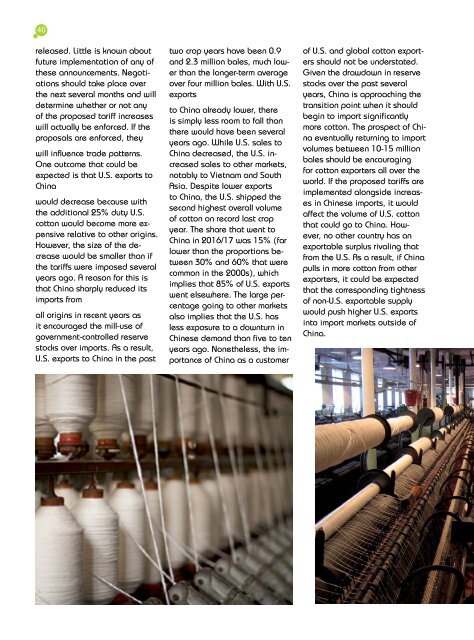SleepTech July - August 2018
SleepTech July - August 2018
SleepTech July - August 2018
Create successful ePaper yourself
Turn your PDF publications into a flip-book with our unique Google optimized e-Paper software.
40<br />
released. Little is known about<br />
future implementation of any of<br />
these announcements. Negotiations<br />
should take place over<br />
the next several months and will<br />
determine whether or not any<br />
of the proposed tariff increases<br />
will actually be enforced. If the<br />
proposals are enforced, they<br />
will influence trade patterns.<br />
One outcome that could be<br />
expected is that U.S. exports to<br />
China<br />
would decrease because with<br />
the additional 25% duty U.S.<br />
cotton would become more expensive<br />
relative to other origins.<br />
However, the size of the decrease<br />
would be smaller than if<br />
the tariffs were imposed several<br />
years ago. A reason for this is<br />
that China sharply reduced its<br />
imports from<br />
all origins in recent years as<br />
it encouraged the mill-use of<br />
government-controlled reserve<br />
stocks over imports. As a result,<br />
U.S. exports to China in the past<br />
two crop years have been 0.9<br />
and 2.3 million bales, much lower<br />
than the longer-term average<br />
over four million bales. With U.S.<br />
exports<br />
to China already lower, there<br />
is simply less room to fall than<br />
there would have been several<br />
years ago. While U.S. sales to<br />
China decreased, the U.S. increased<br />
sales to other markets,<br />
notably to Vietnam and South<br />
Asia. Despite lower exports<br />
to China, the U.S. shipped the<br />
second highest overall volume<br />
of cotton on record last crop<br />
year. The share that went to<br />
China in 2016/17 was 15% (far<br />
lower than the proportions between<br />
30% and 60% that were<br />
common in the 2000s), which<br />
implies that 85% of U.S. exports<br />
went elsewhere. The large percentage<br />
going to other markets<br />
also implies that the U.S. has<br />
less exposure to a downturn in<br />
Chinese demand than five to ten<br />
years ago. Nonetheless, the importance<br />
of China as a customer<br />
of U.S. and global cotton exporters<br />
should not be understated.<br />
Given the drawdown in reserve<br />
stocks over the past several<br />
years, China is approaching the<br />
transition point when it should<br />
begin to import significantly<br />
more cotton. The prospect of China<br />
eventually returning to import<br />
volumes between 10-15 million<br />
bales should be encouraging<br />
for cotton exporters all over the<br />
world. If the proposed tariffs are<br />
implemented alongside increases<br />
in Chinese imports, it would<br />
affect the volume of U.S. cotton<br />
that could go to China. However,<br />
no other country has an<br />
exportable surplus rivaling that<br />
from the U.S. As a result, if China<br />
pulls in more cotton from other<br />
exporters, it could be expected<br />
that the corresponding tightness<br />
of non-U.S. exportable supply<br />
would push higher U.S. exports<br />
into import markets outside of<br />
China.

















